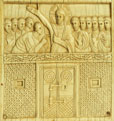UNA BIBBIA IN AVORIO
Arte mediterranea nella Salerno dell’XI secolo
Schede di Serena La Mantia
Fotografie di Marcello de Masi
Formato cm 21 x 25
Brossura con alette
208 pagine a colori
© 2016 Ultreya
Nella seconda metà dell’XI secolo la Campania visse uno dei suoi momenti più alti. Assai importante per il suo ruolo fu l’arcivescovo di Salerno Alfano. Della cattedra vescovile che dovette commissionare personalmente restano 67 tavolette eburnee. Il programma della cattedra, che si incentra su temi e scene del Vecchio e Nuovo Testamento, raffigura la storia della salvezza. L’opera fu eseguita in avorio, materiale per preziosità inferiore solo all’oro. L’avorio infatti richiedeva una tecnica esecutiva che necessitava artisti che sapessero utilizzare al meglio la zanna dell’elefante e trarne le sottili lamine sulle quali intagliare le scene.
Tutto converge a rendere possibile e verosimile un progetto e un’esecuzione dell’opera per la cattedrale di Amalfi del tempo di Alfano.
È questa la più ampia serie di formelle eburnee appartenenti a un manufatto anteriore all’età gotica. Esse testimoniano un manufatto che, per la preziosità del suo materiale e per qualità esecutiva, oltre che per l’interesse intrinseco del suo ciclo narrativo, non ha paragoni.
![]()
Valentino Pace
A BIBLE IN IVORY
Mediterranean art in 11th century Salerno
Texts by Serena La Mantia
Photographs by Marcello de Masi
Size 21 x 25 cm
Softcover with flaps
208 pages in color
© 2016 Ultreya
In the second half of the 11th century, Campania lived one of its high. Just as significant for his role was that of the archbishop of Salerno, Alfano. Remain 67 ivory plaques of the episcopal cathedra that Alfano is said to have personally commissioned. The narrative of the cathedra, which focuses on themes and scenes from the Old and New Testaments, depicts the history of salvation. The piece was realized in ivory, a material of a precious nature inferior only to gold. Working with ivory required advanced technique; artists were needed who knew the best ways of using an elephant tusk and take from it the thin layers in which they could carve a scene.
All this evidence, therefore, combines to unquestionably ground the possibility and plausibility that the work was planned and executed for the cathedral of Amalfi during the time of Alfano. This is the most extensive series of ivory panels belonging to an artifact that predates the Gothic Era. The panels are a witness to artistic production that, for the precious nature of the material and the quality of execution, not to mention the intrinsic interest of its narrative sequence, is without comparison.
